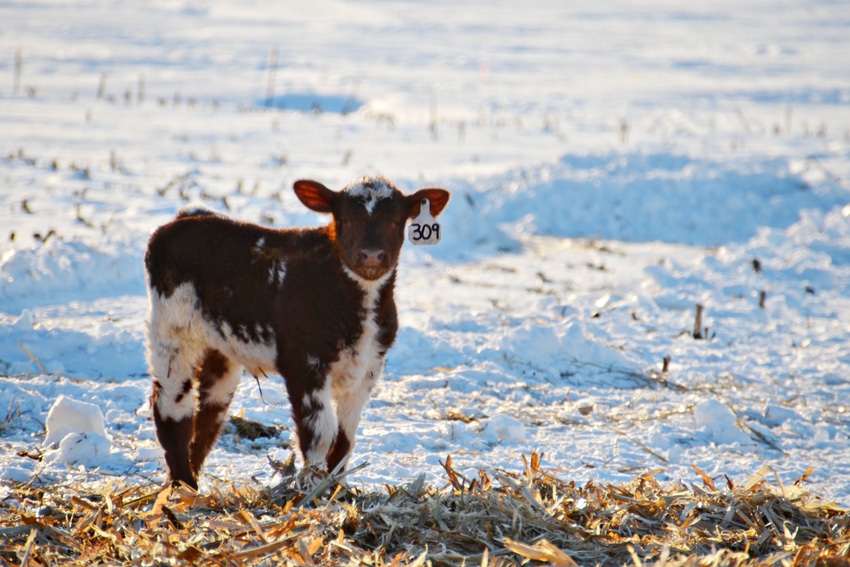January 8, 2015

In my neck of the woods, we enjoyed warmer-than-average temperatures in December and through the holiday season. It’s now January, however, and Mother Nature has switched gears and brutally cold winter weather has arrived. In fact, despite the weatherman promising “plentiful sunshine” today, even a bright sun can’t take the sting out of a high of -9 °F with 20 mph winds that make it feel like -29°.
Ranchers don’t have the luxury of calling off work and hunkering down in the house when things get cold. Part of the rancher’s job description is weathering the elements – whatever they are – and making sure the cattle are tended to. We know what we need and can provide for ourselves. Fortunately for us, we also have warm trucks and tractors, plenty of warm layers to wear, and plenty of hot coffee to keep us from freezing when the weather gets tough.
Cattle are built to handle all sorts of weather conditions if they have the proper nutrition, body insulation and wind breaks. Still, special attention must be paid to ensure that’s all available when the temperatures drop to the extreme lows we’re currently seeing.
Subscribe now to Cow-Calf Weekly to get the latest industry research and information in your inbox every Friday!
Here are four considerations for managing the effects of cold stress on beef cows.
1. Reduce wind speeds to increase animal comfort
Warren Rusche, South Dakota State University Extension cow-calf field specialist, says that wind speed can drop the effective temperature dramatically.
“Most beef producers understand that when the weather gets colder their cows need more energy to maintain their body condition,” says Rusche. “The questions are when do cows start experiencing cold stress and then how much more energy do they need? When we’re considering cold stress, we need to factor in both the actual temperature and the wind speed to determine the effective temperature. Any kind of available protection, whether natural or man-made, can be very valuable in reducing the amount of wind chill.”
2. Cows’ energy needs increase as the the temperature drops
Rusche says, “As a general rule, for every degree that the effective temperature is below the lower critical temperature, the cow’s energy needs increase by 1%. For instance, if the effective temperature is 17 °F, the energy needs of a cow with a dry winter coat are about 15% higher than they would be under more moderate conditions. That energy requirement jumps up to about 40% higher under those conditions if the hair coat is completely wet or matted down with mud.
“One of the ways that the cow responds to cold stress is by increasing voluntary feed intake. The animal’s entire metabolism system increases in activity. Also, the passage rate of roughages through the rumen and digestive tract increases. These changes trigger an increase in the cow’s appetite and voluntary intake.”
3. Make sure feed intake is maintained
Rusche says, “There are some management considerations that we need to keep in mind regarding changes in feed intake in response to cold stress and the cow’s need for more energy. Make sure that water is available. If water availability is restricted, feed intake will be reduced. If the feed availability is limited, either by snow cover or access to hay feeders, the cattle may not have the opportunity to eat as much as their appetite would dictate. Be careful providing larger amounts of high-concentrate feeds. Rapid diet changes could cause significant digestive upsets.”
4. Sort off thin cows for more specialized care
Chris Clark, Iowa State University Extension and Outreach beef program specialist, suggests sorting off thin cows to a separate area.
“By sorting off thinner cows to a separate area, you can provide them with a higher-quality ration while eliminating competition from other cows. If you are using lower-quality forages, it’s important to supplement those forages appropriately to meet animal requirements. Nutrient requirements go up throughout the third trimester and early lactation, so cows that are thin right now will need a high plane of nutrition to keep up with fetal growth, milk production and Iowa winter weather.”
What special steps do you take to reduce cold stress in your herd? Share your thoughts in the comments section below.
The opinions of Amanda Radke are not necessarily those of Beefmagazine.com or the Penton Farm Progress Group.
You might also like:
15 photos of cowboy hats in action
Breathtaking photos of winter on the ranch
6 tips for buyers & sellers at a cattle sale
You May Also Like

.png?width=300&auto=webp&quality=80&disable=upscale)
.png?width=300&auto=webp&quality=80&disable=upscale)
